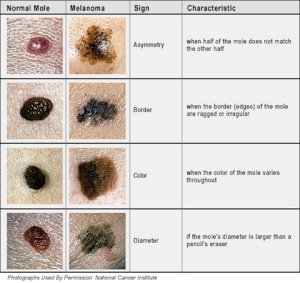Summer is coming (finally!) and you notice that because more people are outside enjoying the day. Being active outdoors is an important part of a healthy lifestyle and the sunlight also provides positive effects on us such as the stimulation of vitamin D synthesis, heat and the release of the hormone of happiness – the serotonin. However, it is important to know that the Sun has bad consequences on our skin and we should protect ourselves from it. Underestimating the risk of the sun and its potential to cause skin cancer is risky.
Skin cancer is the most common cancer in Caucasians, with around 240.000 people diagnosed every year and its incidence is rising rapidly: is the 5th most common form of cancer in the United Kingdom and malignant melanoma is the 19th most common cancer worldwide.
According to this picture, the highest incidence rate of skin cancer worldwide is in Australia and New Zealand, where it is the 3rd most common cancer in males and females. In addition, Nordic countries are exposed to the sun during holidays at lower latitudes and they have experienced an increase in the number of skin cancer cases.
European countries such as Denmark, Sweden and The Netherlands are the three countries with the highest incidence rate of skin cancer, whilst Greece, Romania and Cyprus are the lowest ones.
The skin cancer is one of the most frequent tumours in humans and it can have different features. Nevertheless, not all the skin changes are cancer. Therefore, a regular visit to the dermatologist is a good practice when the person sees any change or has many freckles on the skin.
The early diagnosis and the correct treatment increase the probabilities to cure it.
The ozone layer protects the Earth from the UV-light, which rays are dangerous. According to some recent studies, the ozone layer is becoming thinner and thus, a good sun protection is extremely important in order to decrease the health risk of suffering skin cancer.
The most common types of skin cancer are:
- Malignant melanoma.
- Non-melanoma skin cancer: basal cell carcinoma and squamous cell carcinoma.
- Rare types of non-melanoma skin cancer: Kaposi’s sarcoma, Merkel cell carcinoma and T cell lymphoma of the skin.
Effects on the skin
There are two types of UV-light radiation: UV-B radiation and UV-A radiation. The first one has shorter wavelengths than the latter one.
The UV-B radiation normally induces a sunburn and is the most effective in inducing an erythema (redness, sunburn) on the skin, whilst the UV-A radiation is less potent in inducing an erythema, and usually tans our skin. Nevertheless, UV-A radiation penetrates deeper in the skin and causes wrinkles, premature skin aging and pigment alterations.
Both types of radiation are one of the risk factors for the development of skin cancer. The UV-B radiation induces genetic changes in the DNA and UV-A radiation does it by photooxidation mechanisms and contributing to the formation of oxygen free radicals that significantly form cutaneous tumours.
Skin cancer risk factors
- Age and sex
- UV- radiation (from sun exposure and sunbeds)
- Skin type, hair and eye colour: higher risk in people with blue/green eyes, red/blonde hair and with freckles.
- Moles
- Family history and genetic conditions
- Previous cancer
- Medical conditions and treatments: increased skin cancer risk in some medical conditions may be linked with use of the immunosuppressants azathioprine and cyclosporine, and the eczema treatment. It is also related to several diseases: Chron’s disease, atopy and allergy, Parkinson’s disease and rheumatoid artritis.
- Infections: having HIV (human immunodeficiency virus) and HPV (human papillomavirus) arise the risk of skin cancer.
- Height: the risk is higher in women than in men and it increases with height.
- Overweight and obesity: there is an increased risk of skin cancer in overweight and obese men; nonetheless, this association is inverted in women
- Ionising radiation: X radiation, gamma radiation, radiotherapy and CT (computed tomography) are classified as skin cancer causes.
- Occupational exposures
Diagnosis and treatment
A screening programme of the skin (breast and cervical regions) is the procedure followed in order to detect cancer cells in the skin. This screening is carried out by a specialist (dermatologist). The vast majority of women and men diagnosed with skin cancer present a stage I.
In order to treat malignant melanoma, the gold treatment when the tumour is localised is surgery. However, radiotherapy (sometimes alongside with chemotherapy) is also used to cure or palliate the tumour growth.
In the case of non-melanoma skin cancer the key treatments are surgical removal, photodynamic therapy (PDT), which uses light therapy combined with a photosensitive cream that destroys cancer cells, and radiotherapy (X-rays machines).
You can also find information related to skin cancer clinical trials performed in the UK; for instance, to treat acral and mucosal melanoma skin cancer that has spread with nilotinib.
Useful Tips:
A self examination is a good practice in order to detect any change in your skin and can save your life. Once a month, after a bath or shower, stand in front of a full-lenght mirror and check yourself.
- Avoid sun at midday (between 11 am and 3 pm)
- Use sun screen daily and with > 30 SPF
- Apply sun screens 20-30 minutes before sun exposure
- Wear a hat or a cap to protect your head
- Wear sunglasses to protect your eyes!
- Drink enough water (make sure you are hydrated)
- Avoid artificial sun light (sun beds/tanning salons)!
- Arrange regular dermatologic skin exams with your specialist/GP!
Enjoy the Summer and the Sun with the correct protection!






